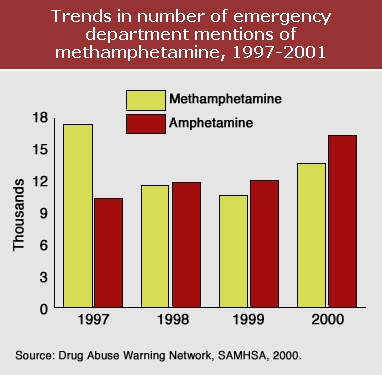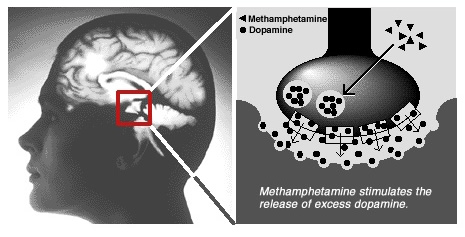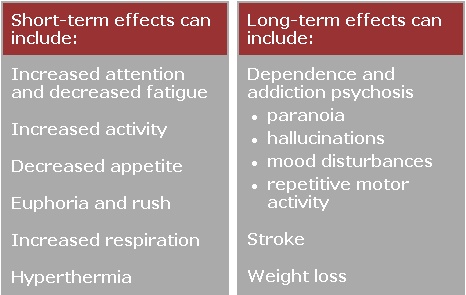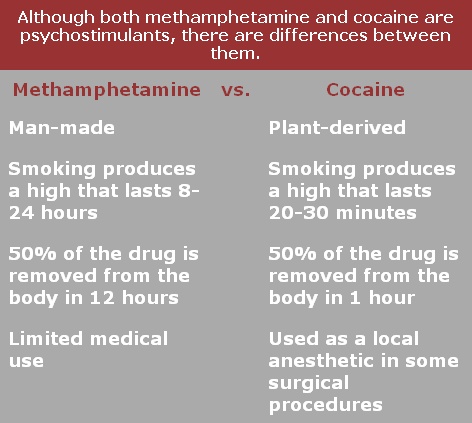Research Report Series: Methamphetamine Abuse and Addiction
Download PDF Version What is PDF?
Source: NIDA Research Report Series: Methamphetamine Abuse and Addiction, NIH
Publication Number 02-4210, Printed April 1998, Reprinted January 2002.
Public Domain
Table of Contents (TOC)
From the DirectorChapter 1: What is methamphetamine?
Chapter 2: What is the scope of methamphetamine abuse in the United States?
Chapter 3: How is methamphetamine used?
Chapter 4: What are the immediate (short-term) effects of methamphetamine abuse?
Chapter 5: What are the long-term effects of methamphetamine abuse?
Chapter 6: How is methamphetamine different from other stimulants, such as cocaine?
Chapter 7: What are the medical complications of methamphetamine abuse?
Chapter 8: Are methamphetamine abusers at risk for contracting HIV/AIDS and hepatitis B and C?
Chapter 9: What treatments are effective for methamphetamine abusers?
Glossary
References
The abuse of methamphetamine - a potent psychostimulant - is an extremely serious and growing problem. Although use of methamphetamine initially was limited to a few urban areas in the Southwest, several major Western cities and Hawaii have seen dramatic increases in its use, and rural areas throughout the country are becoming more affected by the drug. In addition, methamphetamine use among significantly diverse populations has been documented.
As part of our Methamphetamine Research Initiative, the National Institute on Drug Abuse (NIDA) has developed this publication to provide an overview of the latest scientific findings on this drug. Methamphetamine is a powerfully addictive stimulant associated with serious health conditions, including memory loss, aggression, psychotic behavior, and potential heart and brain damage; it also contributes to increased transmission of hepatitis and HIV/AIDS.
One of NIDA’s most important goals is to translate what scientists learn from research to help the public better understand drug abuse and addiction and to develop more effective strategies for their prevention and treatment. We hope this compilation of scientific information about methamphetamine will help inform readers about the harmful effects of methamphetamine abuse and will assist in prevention and treatment efforts.
Glen R. Hanson, Ph.D., D.D.S.
Acting Director
National Institute on Drug Abuse
Methamphetamine is a powerfully addictive stimulant that dramatically affects the central nervous system. The drug is made easily in clandestine laboratories with relatively inexpensive over-the-counter ingredients. These factors combine to make methamphetamine a drug with high potential for widespread abuse.
Methamphetamine is commonly known as "speed," "meth," and "chalk." In its smoked form, it is often referred to as "ice," "crystal," "crank," and "glass." It is a white, odorless, bitter-tasting crystalline powder that easily dissolves in water or alcohol. The drug was developed early in this century from its parent drug, amphetamine, and was used originally in nasal decongestants and bronchial inhalers. Methamphetamine’s chemical structure is similar to that of amphetamine, but it has more pronounced effects on the central nervous system. Like amphetamine, it causes increased activity, decreased appetite, and a general sense of well-being. The effects of methamphetamine can last 6 to 8 hours. After the initial "rush," there is typically a state of high agitation that in some individuals can lead to violent behavior.
 The Drug Abuse Warning Network tracks the number of times a drug is mentioned in connection with emergency room visits in 21 metropolitan areas.
The Drug Abuse Warning Network tracks the number of times a drug is mentioned in connection with emergency room visits in 21 metropolitan areas. Methamphetamine is a Schedule II stimulant, which means it has a high potential for abuse and is available only through a prescription that cannot be refilled. There are a few accepted medical reasons for its use, such as the treatment of narcolepsy, attention deficit disorder, and - for short-term use - obesity; but these medical uses are limited.
Methamphetamine abuse, long reported as the dominant drug problem in the San Diego, CA, area, has become a substantial drug problem in other sections of the West and Southwest, as well. There are indications that it is spreading to other areas of the country, including both rural and urban sections of the South and Midwest. Methamphetamine, traditionally associated with white, male, blue-collar workers, is being used by more diverse population groups that change over time and differ by geographic area.
According to the 2000 National Household Survey on Drug Abuse, an estimated 8.8 million people (4.0 percent of the population) have tried methamphetamine at some time in their lives.
Data from the 2000 Drug Abuse Warning Network (DAWN), which collects information on drug-related episodes from hospital emergency departments in 21 metropolitan areas, reported that methamphetamine-related episodes increased from approximately 10,400 in 1999 to 13,500 in 2000, a 30 percent increase. However, there was a significant decrease in methamphetamine-related episodes reported between 1997 (17,200) and 1998 (11,500).

NIDA’s Community Epidemiology Work Group (CEWG), an early warning network of researchers that provides information about the nature and patterns of drug use in major cities, reported in its June 2001 publication that methamphetamine continues to be a problem in Hawaii and in major Western cities, such as San Francisco, Denver, and Los Angeles. Methamphetamine availability and production are being reported in more diverse areas of the country, particularly rural areas, prompting concern about more widespread use.
Drug abuse treatment admissions reported by the CEWG in June 2001 showed that methamphetamine remained the leading drug of abuse among treatment clients in the San Diego area and Hawaii. Stimulants, including methamphetamine, accounted for smaller percentages of treatment admissions in other states and metropolitan areas of the West (e.g., 9 percent in Los Angeles and Seattle and 8 percent in Texas). By comparison, stimulants were the primary drugs of abuse in a smaller percent of treatment admissions in most Eastern and Midwestern metropolitan areas, such as Minneapolis-St. Paul and St. Louis, where they accounted for approximately 3 percent of total admissions, or Baltimore, where no stimulant-related treatment admissions were reported in the first half of 2000.
Methamphetamine comes in many forms and can be smoked, snorted, orally ingested, or injected. The drug alters moods in different ways, depending on how it is taken.
Immediately after smoking the drug or injecting it intravenously, the user experiences an intense rush or "flash" that lasts only a few minutes and is described as extremely pleasurable. Snorting or oral ingestion produces euphoria - a high but not an intense rush. Snorting produces effects within 3 to 5 minutes, and oral ingestion produces effects within 15 to 20 minutes.
As with similar stimulants, methamphetamine most often is used in a "binge and crash" pattern. Because tolerance for methamphetamine occurs within minutes - meaning that the pleasurable effects disappear even before the drug concentration in the blood falls significantly - users try to maintain the high by binging on the drug.
In the 1980’s, "ice," a smokable form of methamphetamine, came into use. Ice is a large, usually clear crystal of high purity that is smoked in a glass pipe like crack cocaine. The smoke is odorless, leaves a residue that can be resmoked, and produces effects that may continue for 12 hours or more.
In the brain, dopamine plays an important role in the regulation of pleasure. In addition to other regions, dopamine is manufactured in nerve cells within the ventral tegmental area and is released in the nucleus accumbens and the frontal cortex.

As a powerful stimulant, methamphetamine, even in small doses, can increase wakefulness and physical activity and decrease appetite. A brief, intense sensation, or rush, is reported by those who smoke or inject methamphetamine. Oral ingestion or snorting produces a long-lasting high instead of a rush, which reportedly can continue for as long as half a day. Both the rush and the high are believed to result from the release of very high levels of the neurotransmitter dopamine into areas of the brain that regulate feelings of pleasure.
Methamphetamine has toxic effects. In animals, a single high dose of the drug has been shown to damage nerve terminals in the dopamine-containing regions of the brain. The large release of dopamine produced by methamphetamine is thought to contribute to the drug’s toxic effects on nerve terminals in the brain. High doses can elevate body temperature to dangerous, sometimes lethal, levels, as well as cause convulsions.
 Long-term methamphetamine abuse results in many damaging effects, including addiction. Addiction is a chronic, relapsing
disease, characterized by compulsive drug-seeking and drug use which is accompanied by functional and molecular changes in the brain. In
addition to being addicted to methamphetamine, chronic methamphetamine abusers exhibit symptoms that can include violent behavior, anxiety,
confusion, and insomnia. They also can display a number of psychotic features, including paranoia, auditory hallucinations, mood disturbances,
and delusions (for example, the sensation of insects creeping on the skin, which is called "formication"). The paranoia can result in homicidal
as well as suicidal thoughts.
Long-term methamphetamine abuse results in many damaging effects, including addiction. Addiction is a chronic, relapsing
disease, characterized by compulsive drug-seeking and drug use which is accompanied by functional and molecular changes in the brain. In
addition to being addicted to methamphetamine, chronic methamphetamine abusers exhibit symptoms that can include violent behavior, anxiety,
confusion, and insomnia. They also can display a number of psychotic features, including paranoia, auditory hallucinations, mood disturbances,
and delusions (for example, the sensation of insects creeping on the skin, which is called "formication"). The paranoia can result in homicidal
as well as suicidal thoughts.
With chronic use, tolerance for methamphetamine can develop. In an effort to intensify the desired effects, users may take higher doses of the drug, take it more frequently, or change their method of drug intake. In some cases, abusers forego food and sleep while indulging in a form of binging known as a "run," injecting as much as a gram of the drug every 2 to 3 hours over several days until the user runs out of the drug or is too disorganized to continue. Chronic abuse can lead to psychotic behavior, characterized by intense paranoia, visual and auditory hallucinations, and out-of-control rages that can be coupled with extremely violent behavior.
Although there are no physical manifestations of a withdrawal syndrome when methamphetamine use is stopped, there are several symptoms that occur when a chronic user stops taking the drug. These include depression, anxiety, fatigue, paranoia, aggression, and an intense craving for the drug.
In scientific studies examining the consequences of long-term methamphetamine exposure in animals, concern has arisen over its toxic effects on the brain. Researchers have reported that as much as 50 percent of the dopamine-producing cells in the brain can be damaged after prolonged exposure to relatively low levels of methamphetamine. Researchers also have found that serotonin-containing nerve cells may be damaged even more extensively. Whether this toxicity is related to the psychosis seen in some long-term methamphetamine abusers is still an open question.

Methamphetamine is classified as a psychostimulant, as are other drugs of abuse such as amphetamine and cocaine. We know that methamphetamine is structurally similar to amphetamine and the neurotransmitter dopamine, but it is quite different from cocaine. Although these stimulants have similar behavioral and physiological effects, there are some major differences in the basic mechanisms of how they work at the level of the nerve cell. However, the bottom line is that methamphetamine, like cocaine, results in an accumulation of the neurotransmitter dopamine, and this excessive dopamine concentration appears to produce the stimulation and feelings of euphoria experienced by the user. In contrast to cocaine, which is quickly removed and almost completely metabolized in the body, methamphetamine has a much longer duration of action and a larger percentage of the drug remains unchanged in the body. This results in methamphetamine being present in the brain longer, which ultimately leads to prolonged stimulant effects.

Methamphetamine can cause a variety of cardiovascular problems. These include rapid heart rate, irregular heartbeat, increased blood pressure, and irreversible, stroke-producing damage to small blood vessels in the brain. Hyperthermia (elevated body temperature) and convulsions occur with methamphetamine overdoses, and if not treated immediately, can result in death.
Chronic methamphetamine abuse can result in inflammation of the heart lining, and among users who inject the drug, damaged blood vessels and skin abscesses. Methamphetamine abusers also can have episodes of violent behavior, paranoia, anxiety, confusion, and insomnia. Heavy users also show progressive social and occupational deterioration. Psychotic symptoms can sometimes persist for months or years after use has ceased.
Acute lead poisoning is another potential risk for methamphetamine abusers. A common method of illegal methamphetamine production uses lead acetate as a reagent. Production errors therefore may result in methamphetamine contaminated with lead. There have been documented cases of acute lead poisoning in intravenous methamphetamine abusers.
Fetal exposure to methamphetamine also is a significant problem in the United States. At present, research indicates that methamphetamine abuse during pregnancy may result in prenatal complications, increased rates of premature delivery, and altered neonatal behavioral patterns, such as abnormal reflexes and extreme irritability. Methamphetamine abuse during pregnancy may be linked also to congenital deformities.
Increased HIV and hepatitis B and C transmission are likely consequences of increased methamphetamine abuse, particularly in individuals who inject the drug and share injection equipment. Infection with HIV and other infectious diseases is spread among injection drug users primarily through the re-use of contaminated syringes, needles, or other paraphernalia by more than one person. In nearly one-third of Americans infected with HIV, injection drug use is a risk factor, making drug abuse the fastest growing vector for the spread of HIV in the nation.
 Research also indicates that methamphetamine and related psychomotor stimulants
can increase the libido in users, in contrast to opiates which actually decrease the libido. However,
long-term methamphetamine use may be associated with decreased sexual functioning, at least in men.
Additionally, methamphetamine seems to be associated with rougher sex, which may lead to bleeding and
abrasions. The combination of injection and sexual risks may result in HIV becoming a greater problem
among methamphetamine abusers than among opiate and other drug abusers, something that already seems to
be occurring in California.
Research also indicates that methamphetamine and related psychomotor stimulants
can increase the libido in users, in contrast to opiates which actually decrease the libido. However,
long-term methamphetamine use may be associated with decreased sexual functioning, at least in men.
Additionally, methamphetamine seems to be associated with rougher sex, which may lead to bleeding and
abrasions. The combination of injection and sexual risks may result in HIV becoming a greater problem
among methamphetamine abusers than among opiate and other drug abusers, something that already seems to
be occurring in California.
NIDA-funded research has found that, through drug abuse treatment, prevention, and community-based outreach programs, drug abusers can change their HIV risk behaviors. Drug use can be eliminated and drug-related risk behaviors, such as needle-sharing and unsafe sexual practices, can be reduced significantly thus decreasing the risk of exposure. Therefore, drug abuse treatment is also highly effective in preventing the spread of HIV, hepatitis B, and hepatitis C.
At this time the most effective treatments for methamphetamine addiction are cognitive behavioral interventions. These approaches are designed to help modify the patient’s thinking, expectancies, and behaviors and to increase skills in coping with various life stressors. Methamphetamine recovery support groups also appear to be effective adjuncts to behavioral interventions that can lead to long-term drug-free recovery.
There are currently no particular pharmacological treatments for dependence on amphetamine or amphetamine-like drugs such as methamphetamine. The current pharmacological approach is borrowed from experience with treatment of cocaine dependence. Unfortunately, this approach has not met with much success since no single agent has proven efficacious in controlled clinical studies. Antidepressant medications are helpful in combating the depressive symptoms frequently seen in methamphetamine users who recently have become abstinent.
There are some established protocols that emergency room physicians use to treat individuals who have had a methamphetamine overdose. Because hyperthermia and convulsions are common and often fatal complications of such overdoses, emergency room treatment focuses on the immediate physical symptoms. Overdose patients are cooled off in ice baths, and anticonvulsant drugs may be administered also.
Acute methamphetamine intoxication can often be handled by observation in a safe, quiet environment. In cases of extreme excitement or panic, treatment with antianxiety agents such as benzodiazepines has been helpful, and in cases of methamphetamine-induced psychoses, short-term use of neuroleptics has proven successful.
Addiction: a chronic, relapsing disease, characterized by compulsive drug-seeking and drug use and by neurochemical and molecular changes in the brain.
Analog: a chemical compound that is similar to another drug in its effects but differs slightly in its chemical structure.
Benzodiazepines: drugs that relieve anxiety or are prescribed as sedatives; among the most widely prescribed medications, including valium and librium.
Central nervous system (CNS): the brain and spinal cord.
Craving: a powerful, often uncontrollable desire for drugs.
Designer drug: an analog of a restricted drug that has psychoactive properties.
Detoxification: a process of allowing the body to rid itself of a drug while managing the symptoms of withdrawal; often the first step in a drug treatment program.
Dopamine: a neurotransmitter present in regions of the brain that regulate movement, emotion, motivation, and feelings of pleasure.
Narcolepsy: a disorder characterized by uncontrollable attacks of deep sleep.
Physical dependence: an adaptive physiological state that occurs with regular drug use and results in a withdrawal syndrome when drug use stops.
Psychosis: a mental disorder characterized by symptoms such as delusions or hallucinations that indicate an impaired conception of reality.
Rush: a surge of euphoric pleasure that rapidly follows administration of a drug.
Serotonin: a neurotransmitter that has been implicated in states of consciousness, mood, depression, and anxiety.
Tolerance: a condition in which higher doses of a drug are required to produce the same effect as experienced initially; often leads to physical dependence.
Toxic: temporary or permanent drug effects that are detrimental to the functioning of an organ or group of organs.
Withdrawal: a variety of symptoms that occur after use of an addictive drug is reduced or stopped.
"Blood Level of Intravenous Drug Users," by R.L. Norton, B.T. Burton, and J. McGirr. Journal of Clinical Toxicology 34(4):425-30, 1996.
Epidemiologic Trends in Drug Abuse: Vol. I. Highlights and Executive Summary of the Community Epidemiology Work Group, June 2001. NIH Pub. No. 01-4916A. National Institute on Drug Abuse, 2001.
Epidemiologic Trends in Drug Abuse: Vol. II. Proceedings of the Community Epidemiology Work Group, June 2001. NIH Pub. No. 01-4917A. National Institute on Drug Abuse, 2001.
"Integrating Treatments for Methamphetamine Abuse: A Psychosocial Perspective," by A. Huber, W. Ling, S. Shoptaw, V. Gulati, P. Brethen, and R. Rawson. Journal of Addictive Diseases, 16(4):41-50, 1997.
"Like Methamphetamine, Ecstacy May Cause Long-Term Brain Damage," by R. Mathias. NIDA NOTES 11:7, 1996.
Methamphetamine Abuse (NIDA Capsules). National Institute on Drug Abuse, September 1997.
National Methamphetamine Strategy. U.S. Department of Justice, 1996.
National Survey Results on Drug Use From the Monitoring the Future Study, 1975-1994, Vol. I: Secondary School Students. NIH Pub. No. 93-3498. National Institute on Drug Abuse, 1995.
National Survey Results on Drug Use From the Monitoring the Future Study, 1975-1994, Vol. II: College Students and Young Adults. NIH Pub. No. 96-4027. National Institute on Drug Abuse, 1995.
"NIDA Survey Provides First National Data on Drug Abuse During Pregnancy," by R. Mathias. NIDA NOTES 10:6-7, 1995.
Summary of Findings from the 2000 National Household Survey on Drug Abuse. Substance Abuse and Mental Health Services Administration, 2000.
Detailed Emergency Department Tables 2000, Drug Abuse Warning Network. Substance Abuse and Mental Health Services Administration, available online at www.samhsa.gov/oas/dawn.htm.


